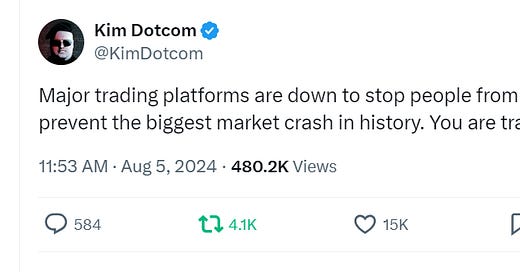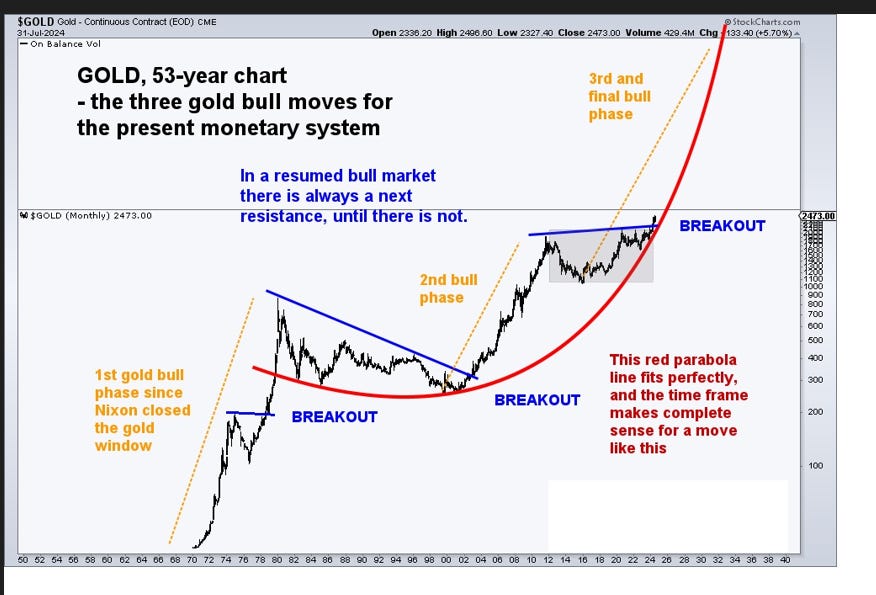Black Monday and Major Trading Platforms are Down to Stop People from Selling Stocks and Prevent the Biggest Market Crash in History.
People are trapped in their positions inside a burning building. But Warren Buffett just got out in time. See how that works.
Fight Back
Buy Gold and Silver
Several major online trading platforms experienced outages today, affecting thousands of users. The platforms impacted include Charles Schwab, Fidelity, Vanguard, and TD Ameritrade, with reports of issues starting around the market's opening at 9:30 a.m. ET. These problems were largely attributed to technical issues amid a sharp decline in global stock markets.
Specific details include:
Over 15,250 Schwab clients reported issues.
More than 3,300 Fidelity clients and 2,890 Vanguard clients faced problems.
Approximately 1,400 TD Ameritrade clients were affected
Throughout the history of England and the Dutch Empire, there have been several instances where markets closed or experienced severe disruptions, leaving investors unable to liquidate their positions. Here are three significant examples:
Dutch Empire
The South Sea Bubble of 1720
This was one of the most infamous financial crises in British history. The South Sea Company, founded in 1711, was granted a monopoly on trade with South America. Speculation in the company's shares led to a massive bubble, with stock prices rising dramatically. When the bubble burst in September 1720, the market effectively collapsed. Many investors, including members of the aristocracy and government officials, were left with worthless shares and unable to sell their positions. The crash was so severe that it led to a ban on the creation of joint-stock companies in England for nearly a century.
The Dutch Tulip Mania of 1636-1637
While not a complete market closure, this event in the Dutch Golden Age represents a classic example of a market bubble and subsequent crash. Speculation in tulip bulbs reached extraordinary levels, with single bulbs selling for more than ten times the annual income of a skilled craftsman. When the market suddenly collapsed in February 1637, many investors were left holding contracts for tulips at inflated prices that buyers refused to honor. The market for tulips essentially disappeared overnight, leaving speculators unable to liquidate their positions.
The Amsterdam Financial Crisis of 1763
This crisis, which occurred after the end of the Seven Years' War, was one of the first international financial crises. It was triggered by a collapse in commodity prices and disruptions in the bullion trade due to currency debasements in Eastern Europe. Several major Amsterdam banking houses became overextended and failed, causing a credit crunch. The crisis spread to other financial centers in Europe, including Hamburg and Berlin. Many investors and traders found themselves unable to sell assets or obtain credit, effectively trapping them in their positions.
These examples demonstrate how market bubbles, speculation, and external economic shocks can lead to situations where investors become trapped in their positions due to sudden market closures or severe illiquidity. They highlight the risks inherent in financial markets and the potential for widespread economic disruption when these events occur.
England
Yes, England also experienced significant market closures and disruptions that left investors unable to liquidate their positions. Here are three notable examples from English financial history:
The Panic of 1825
This was one of the first major financial crises in England. It began with speculative investments in Latin American securities and culminated in a stock market crash and banking crisis. The panic led to widespread bank failures and a severe economic downturn. Many investors were left unable to sell their holdings as the market collapsed, effectively trapping them in their positions.
The Crisis of 1866 (Overend Gurney Crisis)
This crisis is considered a major turning point in British financial history. When Overend, Gurney & Company, a large wholesale bank, collapsed in May 1866, it triggered a widespread panic. The Bank of England initially refused to bail out Overend Gurney, leading to a freeze in the money markets. Many investors and firms found themselves unable to access credit or liquidate assets. The Bank of England eventually responded by lending freely, but not before significant damage had been done to the financial system.
The Stock Exchange Closure of 1914
At the outbreak of World War I in 1914, the London Stock Exchange closed from July 31 to December 23. This was part of a global market shutdown aimed at preventing massive selling and capital flight. During this period, investors were unable to trade their securities through official channels. Although some off-exchange trading occurred, many investors found themselves effectively locked into their positions for several months.
These examples demonstrate that England, like other major financial centers, has experienced periods where market closures or severe illiquidity trapped investors in their positions, often with significant economic consequences.
The performance of gold during various significant economic events in the USA has varied, reflecting the broader economic conditions and policy responses at the time. Here is a detailed look at how gold performed during each of the listed events:
1. 1929 Wall Street Crash
During the Wall Street Crash of 1929, gold prices were relatively stable as the U.S. was on the gold standard, which fixed the price of gold at $20.67 per ounce. The stability of gold prices contrasted sharply with the plummeting stock market, as gold was seen as a safe haven during the ensuing Great Depression.
2. 1937 Recession
The Recession of 1937-38 saw the U.S. still on the gold standard, with gold prices fixed at $35 per ounce since 1934. The sterilization of gold inflows by the Treasury Department in late 1936 contributed to the recession by halting monetary expansion. The policy was reversed in 1938, which helped the economy recover.
3. Kennedy Slide of 1962
The Kennedy Slide of 1962 did not significantly impact gold prices, as the U.S. was still on the gold standard. The price of gold remained fixed at $35 per ounce. The stock market decline was attributed to various factors, including a correction from previous gains and geopolitical tensions, but gold prices did not fluctuate as a result.
4. 1987 Black Monday
During Black Monday in 1987, gold prices initially surged as investors sought a safe haven amid the stock market crash. However, the price of gold quickly stabilized as markets calmed and central banks intervened to restore confidence. Gold's role as a hedge against market volatility was evident during this period.
5. 1989 Friday the 13th Mini Crash
The Friday the 13th mini-crash in 1989 had a limited impact on gold prices. The event was relatively short-lived, and while there was a brief spike in gold prices due to increased demand for safe-haven assets, the prices quickly normalized as the market recovered.
6. Early 1990s Recession
During the early 1990s recession, gold prices experienced some volatility but did not see dramatic changes. The recession was marked by a slowdown in economic activity and rising unemployment, but gold prices remained relatively stable, reflecting broader economic uncertainties rather than sharp movements.
7. 2000 Dot Com Bubble
The bursting of the dot-com bubble in 2000 led to a significant decline in stock prices, but gold prices did not see a substantial increase. The early 2000s were characterized by relatively low inflation and stable gold prices, even as the stock market experienced significant volatility.
8. US Bear Market 2007-2009
Gold prices rose significantly during the bear market from 2007 to 2009, driven by the financial crisis. As the stock market plummeted and economic uncertainty soared, investors flocked to gold as a safe haven, pushing prices from around $650 per ounce in early 2007 to over $1,000 per ounce by early 2009.
9. Financial Crisis of 2007-2009
The financial crisis of 2007-2009 saw a dramatic increase in gold prices, reflecting its status as a safe-haven asset. The crisis led to widespread financial instability, and gold prices surged as investors sought to protect their wealth. The price of gold continued to rise, reaching new highs as the crisis unfolded.
10. 2020 Coronavirus Crash
During the 2020 coronavirus crash, gold prices soared as the pandemic triggered a global economic downturn. Gold reached record highs, surpassing $2,000 per ounce in August 2020, as investors sought safety amid unprecedented market volatility and economic uncertainty. The surge in gold prices was driven by fears of prolonged economic disruption and aggressive monetary easing by central banks.
Gold has historically acted as a safe-haven asset during periods of economic turmoil, with its price often rising when stock markets crash or economic uncertainty increases. However, its performance can vary depending on the broader economic context and specific policy responses at the time.








Fidelity was ‘glitchy’ at 0700. Was down at 9:35 (May have been down sooner). I had a sell order that I placed at 0830. It was a market order, small position that I wanted to dump, already red and I didn’t care about a few cents either way. I figured a limit order might not get filled.
The trade did not execute until 1017. Could be a one off. But by my estimation not only did the major brokerages collide with the FED and Treasury to shut down trading, they were also slow in filling orders. It wasn’t a thinly traded stock and should have been filled immediately.
Interestingly enough, SoFi did not go offline. They also refused to participate in the Robinhood/GME trading halt.
Retail investors who think they can ‘get out’ when the real crash comes may want to reconsider. Ditto with the BTC maxis. I’m sure they won’t.
The FED intervened on Thursday. Again on Friday. Today was a new tactic. Instead of delivering listing the PPT they just colluded with the biggest brokerages to make buying or selling impossible. It’s so damn obvious. There should be a Congressional inquiry tomorrow.
Not that it would do any good. Anyway I’m done. The manipulation is simply too aggravating. I’ve closed all of my open positions except 15 miners, two physical trusts (Uranium and Platinum), one dividend play, and 3 very small lottery tickets outside mining.
Cash. ST T bills. Gold. Silver.
What’s ironic is the portfolio is up 1% today.
Cheers.